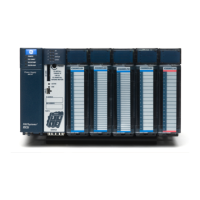Chapter 3. Program Data
GFK-2950C February 2018 33
I/O Variable Format
To map an I/O variable, use the format %vdr.s.[z.]g.t:
v = I (input) or Q (output)
d = data type: X (discrete) or W (analog).
r = rack number
s = slot number
[z] = sub-slot number. This element and the period that follows it appear only if there is a sub-slot,
for example, the SBA number of a Genius device. For an Ethernet daughterboard, set this value to 0.
g = segment number or number of the reference address node. Set to 0 for the first reference
address node on the Terminals tab, 1 for the second reference node, and so on.
t = terminal number. One-based, that is, the numbering begins at 1.
Supported I/O Variable Types
Number of Consecutive Terminals
Required
Number of elements in array.
8n, where n is the number of array elements.
Number of elements in array times 2
Number of elements in array times 2
Number of elements in array
Number of elements in array times 4
Number of elements in array times 2
Number of elements in array
Number of elements in array
I/O Variable Examples
The I/O variable, Sample_IO_Variable is mapped to a non-discrete (W) output point (Q) on the
module located in rack 0, slot 8. The variable is mapped to the first point in the first group of non-
discrete output reference addresses.
The I/O variable, IO_VAR_EXAMPLE, is mapped to a discrete (X) input point (I) on the module located
in rack 0, slot 5. The point is located in the module’s third group of discrete input points and is point 2
in that group.

